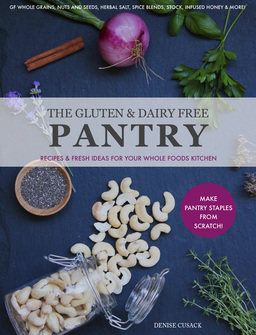|
Part of a whole foods pantry is kitchen staples, spices, and seasonings. Many pre-made mixes these days contain gluten or starches as fillers, not to mention spices that were ground up who knows how long ago and have lost their oomph. By mixing and grinding your own, you can create flavors and aromas for your foods that take your dishes to a whole new level. Also, buying bulk of individual spices to create your own blends can give significant savings over time, and come in much more affordable than the tiny individual jars at the store. Here are a few seasoning blend recipes to get you started. Make enough for yourself, or double/triple the quantity and make to give. A coffee grinder dedicated to spices is great for creating fine blends from woody herbs and spices. Just use one dedicated to spices. If you don’t have that, a pestle and mortar will work, as will pulsing with a food processor (just might require a combination of both to get it fine). Whether you use these to make a primary flavour or to sprinkle over the top, your dishes will never be the same. Plus, many spices and herbs have other properties that boost nutrition, digestion, and are anti-inflammatory. All a plus. Garam Masala Garam Masala is a blend of spices often found in Indian and South Asian cuisines. Each region has their own blend, but the basics are fairly similar. This is a flavorful blend made with spices that can be found in most grocers or spice shops. Everything is listed by tablespoon and teaspoon because it doesn’t have to be exact. Use this as a guide. Garam masala is so good in rice dishes; added to soups and stews, and sprinkled over anything you roast in the oven. 3 Tbsp coriander seeds 1 ½ Tbsp cumin seeds 1 Tbsp sweet cinnamon chips (or a soft woody cinnamon stick) 2 tsp cloves 3 bay leaves 1 tsp cardamom pods (green) ½ tsp peppercorn (I like a variety of peppercorn types) 1 tsp dried ginger ½ of a nutmeg Optional: 1-2 juniper berries Toast all of the spices together on a medium-high skillet, gently, stirring. Be sure not to burn but just toast to release the aroma. Once the spices are warm and toasted, pour them into your spice blender and whiz until you have a powder. Store in an airtight container. Lemon Pepper This lemon pepper is more than just the generic salt from the store. This is a blend of salt, pepper, rosemary, lemon zest and peppercorns. It is very aromatic and is fantastic over meats before grilling or in a salad dressing. Zest of 3-4 lemons (if tiny, use 4) 1/3 cup/80 mL of various peppercorns 5 large sprigs of fresh rosemary ½ cup/120 mL of celtic sea salt Zest your lemons. Whiz your pepper, rosemary, and lemon zest in a food processor to crack the peppercorns and blend. Spread onto a parchment lined sheet and place into a 225ºF/100C (Gas Mark ¼) oven for 20-30 minutes until dry. Once the lemon zest and rosemary are fully dry, pour into a food processor or spice grinder and blend more finely before stirring into your ½ cup of sea salt. Store in an airtight container. Dukka/Duqqa Dukka is an Egyptian mix of herbs, nuts, and spices. This version is nut free so it is safe for nut-free homes. This uses pumpkin, sesame, and sunflower seeds instead of the nuts, giving the dukka a rich, deep, flavor. It is delicious as a crust for meats, as a dip with bread and olive oil, or simply sprinkled over vegetables, salads, or soups. 1 tsp sunflower seeds ¼ cup/60 mL white toasted sesame seeds ½ cup/120mL pumpkin seeds 2 Tbsp coriander seeds 1 Tbsp cumin seeds 1 tsp black peppercorns 1 tsp smoked paprika 1 bay leaf In a dry skillet on medium-high, toast your coriander, peppercorns, pumpkin seeds, sunflower seeds, sesame, cumin seeds, and bay. Stir often, so they don’t burn. You are toasting to warm to release the aroma and oils. Pulse all of your toasted ingredients in a food processor or spice grinder with the smoked paprika. Pulse until you have the consistency you prefer. Coarse is great for dishes, more fine is wonderful for bread and olive oil appetizers. Store in an airtight container. Making your own spice blends and pantry staples can be very easy and the reward is so much more flavorful than you can find in most grocery stores.
0 Comments
So ---- today is the day for our launch of Kitchen: DIY! This is a FREE 30-page book with some of our favorite kitchen DIY projects. Brice (my husband) and I have written many articles on home projects and this is a compilation of some of our favorites we wrote together. We are always asked about our hydroponics system and we go through how to choose and setup a system that is right for you. Another favorite is how to roast your own coffee - in a roaster or even on your grill or over a campfire (plus...recipes). How to sprout and which seeds are the best to start with. How to get started growing mushrooms - what are the different types of starter setups from tabletop to logs - and what types of mushrooms can you grow (plus...recipes). Brice also has a great article about grilling with hardwood charcoal and not the little chemical bomb briquettes. Of course this is filled with photos and recipes and detailed information with resources! Happy DIY'ing.
>>If you are on a non-Apple device, you can download a PDF version here! 
Be sure to keep an eye out here - I will be launching another ebook The Gluten and Dairy Free Pantry: Recipes and Fresh Ideas for Your Whole Foods Kitchen in the next few weeks! |
denise cusackI am a certified aromatherapist, clinical herbalist, permaculture designer, organic gardener, plant conservationist, photographer, writer, designer, artist, nature lover, health justice activist, whole foods maker, and mother of two young adults in south central Wisconsin. Categories
All
©2007-23 Denise Cusack, all photos and text. Feel free to share my posts on FB or Twitter or online media or pin on Pinterest (thank you!), but please keep the links back to my website intact (meaning please do not take or copy my images off of this website and share them unattributed or without linking back here or use them without permission). Thank you! :)
|
